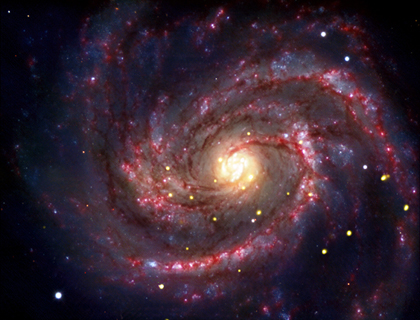-
SN 1979C, a supernova in the galaxy M100, may be the youngest black hole in the so-called local Universe.
-
Astronomers have seen many gamma-ray bursts, which are likely the births of young black holes, but these are much more distant.
-
If SN 1979C does indeed contain a black hole, it will give astronomers a chance to learn more about which stars make black holes and which create neutron stars.
-
SN 1979C was first reported by an amateur astronomer, and some 25 years later space-based telescopes picked up the case.
This composite image shows a supernova within the galaxy M100 that may contain the youngest known black hole in our cosmic neighborhood. In this image, Chandra's X-rays are colored gold, while optical data from ESO's Very Large Telescope are shown in yellow-white and blue, and infrared data from Spitzer are red. The location of the supernova, known as SN 1979C, is labeled (roll your mouse over the image above).
SN 1979C was first reported to be seen by an amateur astronomer in 1979. The galaxy M100 is located in the Virgo Cluster about 50 million light years from Earth. This approximately 30-year age, plus its relatively close distance, makes SN 1979C the nearest example where the birth of a black hole has been observed, if the interpretation by the scientists is correct.
To read the rest of the article, click here.
